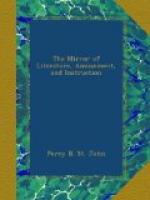Mr. Bowman, F.L.S. says, “We arrested several of these little aeronauts in their flight, and placed them on the brass gnomon of the sundial, and had the gratification to see them prepare for, and recommence, their aerial voyage. Having crawled about for a short time, to reconnoitre, they turned their abdomens from the current of air, and elevated them almost perpendicularly, supporting themselves solely on the claws of their fore legs, at the same instant shooting out four or five, often six or eight, extremely fine webs, several yards long, which waved in the breeze, diverging from each other like a pencil of rays, and strongly reflecting the sunbeams. After the insects had remained stationary in this apparently unnatural position for about half a minute, they sprang off from the stage with considerable agility, and launched themselves into the air. In a few seconds after they were seen sailing majestically along, without any apparent effort, their legs contracted together, and lying perfectly quiet on their backs, suspended from their silken parachutes, and presenting to the lover of nature a far more interesting spectacle than the balloon of the philosopher. One of these natural aeronauts I followed, which, sailing in the sunbeams, had two distinct and widely diverging fasciculi of webs, and their position in the air was such, that a line uniting them would have been at right angles with the direction of the breeze.”—Mag. Natural History.
The Ichneumon Fly.
There are several species of ichneumon which make thinnings among the caterpillars of the cabbage butterfly. The process of one species is this:—while the caterpillar is feeding, the ichneumon fly hovers over it, and, with its piercer, perforates the fatty part of the caterpillar’s back in many places, and in each deposits an egg, by means of the two parts of the sheath uniting together, and thus forming a tube down which the egg is conveyed into the perforation made by the piercer of the fly. The caterpillar unconscious of what will ensue keeps feeding on, until it changes into a chrysalis; while in that torpid state, the eggs of the ichneumon are hatched, and the interior of the body of the caterpillar serves as food for the caterpillars of the ichneumon fly. When these have fed their accustomed time, and are about to change into the pupa state, they, by an instinct given them, attack the vital part of the caterpillar (a most wonderful economy in nature, that this process should be delayed until they have no more occasion for food.) They then spin themselves minute cases within the body of the caterpillar; and instead of a butterfly coming forth (which, if a female, would have probably laid six hundred eggs, thus producing as many caterpillars, whose food would be the cabbage,) a race of these little ichneumon flies issues forth, ready to perform the task assigned them, of keeping within due limits those fell destroyers of our vegetables.—Mr. Carpenter—in Gill’s Repository.




